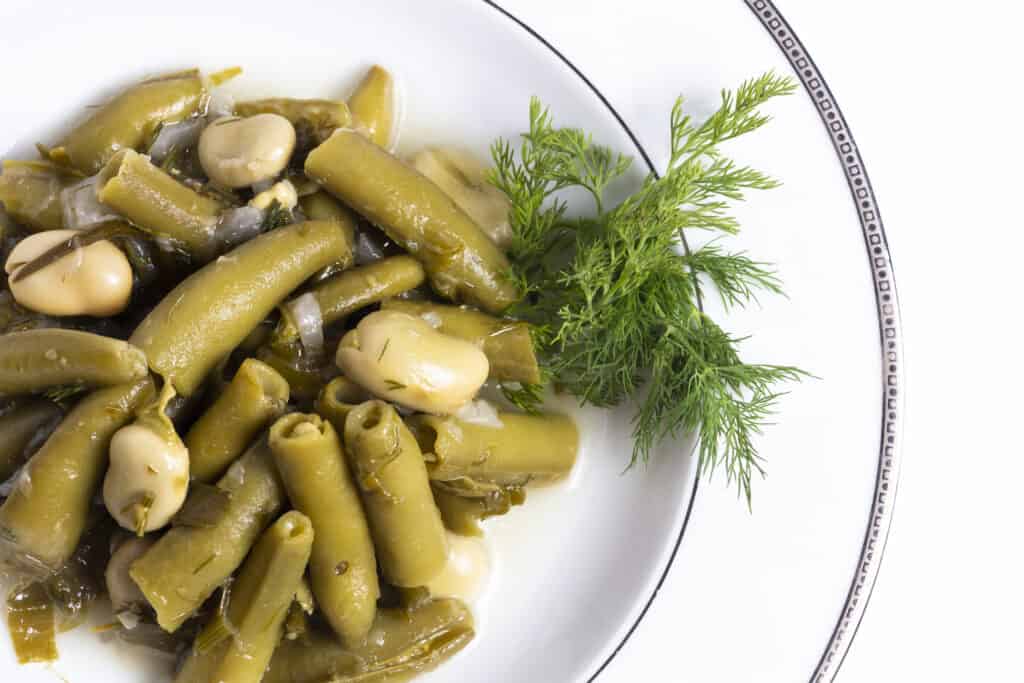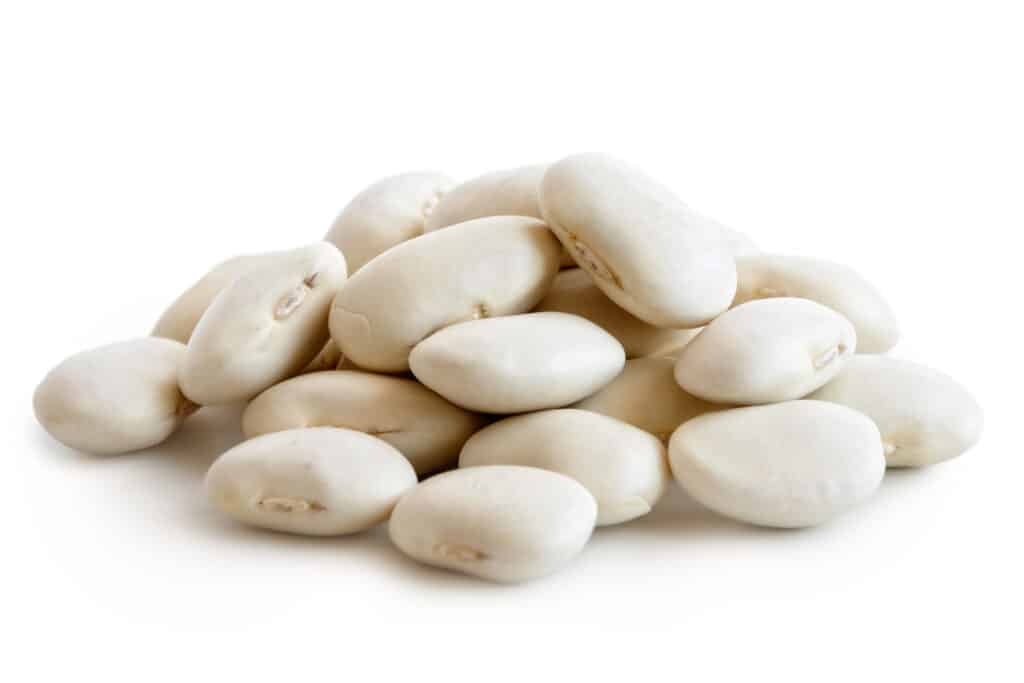If you enjoy growing your own vegetables or cooking with healthy ingredients, you may be interested in learning more about broad beans and lima beans. As members of the legume family, these plants share some similarities in growing characteristics, flowering, and seed production. However, they also contain notable differences, and knowing these differences will help you distinguish the plants and their seeds from each other, as well as safely eat their beans.
So, throw on your gardening gloves and /or dust off your crock pots, ’cause we’re jumping right in!
Broad Beans vs. Lima Beans: A Quick Look
| Broad Bean | Lima Bean | |
|---|---|---|
| Plant Classification | Vicia faba | Phaseolus lunatus |
| Plant Characteristics | Annual legume that grows two to four feet tall. They are bushy with multiple stems originating from the base of the plant. The leaves of the plant are compound, oval to elliptical and broad. Typically grouped in 6 leaflets per stem, flowers are generally lipped with fused petals, and are white or violet with dark splotches | Herbaceous legume that can grow either as a bushy annual or climbing perennial vine. The annual bushy plant can reach up to three feet tall. As a perennial vine, this plant can grow up to 12 feet long. Both annual and perennial plants produce compound, heart-shaped leaflets with white or violet flowers. |
| Ideal Growing Conditions | Prefers to grow in moist, loamy, slightly acidic to neutral soil but can tolerate clay soil and soil with a higher saline concentration. Once established, this plant is fairly drought tolerant. Prefers to grow in full sun. Thrives in USDA hardiness Zones 2-10. | Lima beans prefer to grow in well-draining, loamy, neutral-alkaline soils. However, it is tolerant of a wide range of soil types and is particularly drought tolerant. Prefers to grow in full sun. Thrives in USDA hardiness Zones 2-11. |
| Culinary Uses | A great bean for soups, purees, stews, dips, salads, and sautéing. | A great bean for soups, stews, and succotash. Should not be eaten raw and needs to be thoroughly cooked for safe eating. |
Plant Classification
While both broad beans (Vicia faba) and lima beans (Phaseolus lunatus) are members of the legume family (Fabaceae), they belong to separate botanical genera and species.
Broad beans are part of the Vicia genus, which contains approximately 240 species of flowering plants in the legume family. Members of the Vicia genus are indigenous to parts of Africa, Asia, the Americas, and Europe.
Lima beans are part of the Phaseolus genus, which contains about 70 species, all native to the Americas. Other common names for lima beans include butter beans, Madagascar bean, double bean, and wax bean.
Broad Beans vs. Lima Beans: Plant Characteristics
As members of the legume family, both broad bean and lima bean plants display similar characteristics, typical of many species in their botanical family. Both produce fruiting pods on plants with broad, oval to heart-shaped leaflets. Both have pinnately compound leaves alternately arranged along their stems.
Broad bean grows as a bushy plant that reaches two to six feet tall. Multiple stems originating from the base of the plant contribute to its bushy appearance and growth habit. The leaves of the plant are pinnately compound and alternately arranged along their stems, grouped in six broad, oval to elliptical-shaped leaflets per stem. The pod of this legume is particularly large, growing to between six and 11 inches long, containing up to six beans per pod. The fragrant flowers are white or violet with dark splotches, resembling the shape of pea flowers.

Broad beans grow on bushy plants that can be as tall as six feet!
©iStock.com/SylvieBouchard
While the broad bean has one growing habit, the lima bean plant can actually grow in two different manners depending on climate and cultivar. This plant can grow as a bushy annual or a climbing perennial vine. Leaf and flower characteristics are the same, but the height and growth pattern of the plant can differ. As a bushy annual, this legume can grow up to three feet tall. As a perennial vine, it can reach lengths of up to 12 feet. Leaves are compound and heart-shaped. The flowers are usually either white or pale blue-violet and don’t have dark splotches. They have a similar fragrance and shape to broad bean flowers.

Lima bean vines can reach lengths of up to 12 feet!
©iStock.com/Uncle_Benny
Broad Beans vs. Lima Beans: Ideal Growing Conditions
When comparing broad beans to lima beans, you’ll notice these plants have some similar growing preferences and hardiness. Both of these legume plants prefer loamy, well-draining, moist soil. They are also hardy to drought once established and can tolerate a wide range of non-ideal soil types. Both broad bean and lima bean plants prefer to grow in full sun.
Regarding their differences in growing preferences, it’s important to note that broad beans have a preference for slightly acidic to neutral soil, while lima beans prefer neutral to slightly alkaline soil. Though both are drought tolerant, lima bean plants are notably more drought tolerant. These legume plants grow in similar USDA hardiness Zones, with broad beans thriving in Zones 2-10, and lima beans thriving in zones 2-11.
In its preferred growing temperature of around 70-80 degrees Fahrenheit, lima bean pods will take 60-90 days to mature, depending on whether the plant is a bushy or climbing bean variety. For broad beans growing in their preferred temperature of around 60-70 degrees Fahrenheit, maturity will be reached between 80-100 days.
Culinary Uses
As edible legumes, both broad beans and lima beans are widely used around the world in culinary dishes. Please be aware, however, that while you can eat broad beans raw, lima beans should always be thoroughly cooked to insure safe consumption.
The broad bean is a staple in the kitchen globally, from hearty soups and stews to purees and pastes. It’s also used as bean spread or dip. You can even lightly pan-fry these beans as a side dish or incorporate them into a fresh salad. Broad beans tend to have a slightly sweet, mild flavor.

The broad bean is a global staple in the kitchen.
©iStock.com/feyyazalacam
Since they have to be thoroughly cooked, lima beans are frequently used in soups and stews. They’re also a common ingredient in succotash. Many people describe the taste of lima beans as velvety and buttery. This buttery taste is the reason for one of this plant’s common names, butter bean.

Always thoroughly cook lima beans to insure safe consumption.
©iStock.com/etienne voss
Broad beans and lima beans are tasty, fiber-rich additions to a variety of different dishes. Homegrown or store bought, these two legumes are beloved around the world.
Up Next:
- Can Dogs Eat Beans? Which Beans are Most Dangerous?
- Lentils vs. Beans: What are the Differences?
- Can Your Dog Eat Lima Beans?
The photo featured at the top of this post is © iStock.com/Paul Maguire
Sources
- cabi, Available here: https://www.cabi.org/isc/datasheet/40620#tosummaryOfInvasiveness
- science direct, Available here: https://www.sciencedirect.com/topics/agricultural-and-biological-sciences/phaseolus-lunatus
- a-z-animals, Available here: https://a-z-animals.com/blog/plants-that-smell-good/
- ncsu (1970) Vicia faba (Bell Bean, Broad Bean, English Bean, Fava Bean, Field Bean, Horse Bean, Pidgeon Bean, Tick Bean, Windsor Bean) | North Carolina Extension Gardener Plant Toolbox (ncsu.edu)
Thank you for reading! Have some feedback for us? Contact the AZ Animals editorial team.






